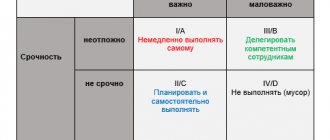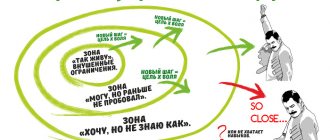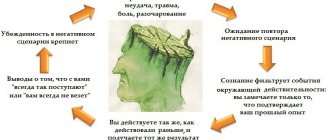In almost any area of life, a person from time to time is faced with the fact that certain obstacles and problems arise on his way. But it is not always possible to determine the true cause of the appearance of a particular problem, and it itself can only be a visible consequence of something that is hidden from our attention somewhere inside ourselves or the activity in which we are engaged. And in order to understand the main causes of problems and eliminate them, it is very convenient to resort to the use of a technique developed specifically for this purpose - the diagram of Kaoru Ishikawa, a professor at the University of Tokyo and a leading specialist in quality management. This diagram is also known as Root Cause Analysis Diagram, Cause and Effect Diagram, and Fishbone Diagram. The presented lesson is dedicated to describing this method as a useful tool in any work and everyday life.
What is an Ishikawa diagram
The Ishikawa method involves carrying out factor analysis of a problem situation. Today it is used in quality assessment and management. The Ishikawa diagram is also called the quality spiral, root cause analysis, fishbone (because the Ishikawa diagram looks like a fishbone), or cause-and-effect analysis. Initially, the technique was used to determine the causes of product defects.
When studying the graphical representation of an Ishikawa diagram, people come to the conclusion that it is a fish skeleton.
Rice. 1 – Graphic representation of the Ishikawa diagram
The main groups of factors of the Ishikawa scheme in production, for example, can be:
- work force;
- management control methods;
- technological process;
- feedstock;
- work environment.
Gradually, the method moved from the economic sphere to other branches of science. So, for example, the Ishikawa method is used in psychology to identify the causes of constant failures in a particular segment of a person’s life path. Building a graphical Ishikawa model allows a person to see a problem from different angles. In the Japanese economy, the Ishikawa cause-and-effect diagram is recognized as one of the most effective methods for assessing product quality.
Preface
In 1953, Tokyo University professor Kaoru Ishikawa, discussing a quality problem in a factory, summarized the engineers' opinions in the form of a cause-and-effect diagram. Over time, the diagram began to be used in practice, and it turned out to be very useful and eventually became widespread in many companies in Japan. Subsequently included in the Japanese Industrial Standard (JIS) for quality control terminology, it is defined as follows: cause-effect diagram - a diagram that shows the relationship between a quality indicator and the factors affecting it. The diagram was named after Kaoru Ishikawa, who made invaluable contributions to the development of industry and economics in Japan. There are two transcriptions of the professor's surname: Ishikawa and Ishikawa
. Ishikawa in Russian pronunciation is Ishikawa. (L.G. Golubkova presentation “Management schemes in the organization”)
Purpose of the method
What is the Ishikawa diagram for? The main purpose of the Ishikawa (or Ishikawa) diagram is to take into account the factors that influence the final result. By developing the diagram, Kaoru Ishikawa sought to determine what caused product defects: problems in organizing the production process, low level of qualifications of workers, quality of raw materials, or lack of modern equipment.
The Ishikawa diagram, which resembles a fishbone, is designed to rank factors to identify major production problems. The final goal of using the Ishikawa diagram is to visualize cause-and-effect relationships and select methods to eliminate negative factors.
Rules for constructing a graphical model
Kaoru Ishikawa advises following certain rules when forming a graphical model of a problem situation:
- All employees participating in the discussion should be aware of the fact that there is a problem. The boss can voice the problem, or the employees themselves can express opinions about the poor quality of the product.
- Wording is entered into the fishbone in the form of short notes so as not to complicate perception with complex sentences.
- Absolutely all factors, even the most insignificant ones, are noted on the sheet. Sometimes it is a minor fact that turns out to be the root cause of the problem.
- After putting forward one or another negative factor, employees express the reasons for its occurrence and suggest ways to eliminate it.
- If necessary, on the branches of the second level in the diagram, you can record not only negative factors, but also those that have a positive effect on production. You can separate them using different colored lines.
Stages of constructing a circuit
To build an Ishikawa diagram, you need to follow certain steps. As a rule, a graphical diagram is drawn up on a sheet of paper or on a board, but you can make an Ishikawa diagram in Excel on a computer.
In his book, Professor Ishikawa suggests sequential steps in constructing a cause-and-effect diagram.
Gather a team for brainstorming
To obtain a comprehensive account of negative factors when drawing up an Ishikawa diagram, a brainstorming method is used. Specialists of various profiles and qualifications are invited to participate in it. Based on their education and experience, each employee will present their vision of the reasons that gave rise to the problem during the brainstorming session.
You need to formulate the main problem and write it down in a large rectangle, which is the head of the fish on the right side of the sheet. A straight line is drawn from this rectangle to the left.
Capture all ideas on a fishbone
It is necessary to identify the blocks of reasons that provoked the problem. These blocks are located above and below the horizontal line. The more significant the problem, the closer to the fish's head it should be placed. From them, inclined lines are drawn to the horizontal axis, forming the branches of the Ishikawa diagram template.
The causes of the problem, identified through brainstorming, are distributed into formulated blocks and written down in the form of shoots on the main branches of the diagram. The construction of the Ishikawa cause-and-effect diagram continues until all the nuances are taken into account.
The reasons are detailed, during which brainstorming participants express their opinions on why this or that problem arose and how it can be eliminated. This information is entered on the diagram in the form of small processes coming from the branches with causes.
Assess the impact of each factor
An analysis of the compiled scheme is carried out, during which the significance of each factor is assessed. Factors of first order, factors of medium importance and minor factors are distinguished.
Work with what you can influence
Those factors that people cannot influence are crossed out. Then the main causes that need to be eliminated first are highlighted. The discussion participants suggest ways to eliminate them.
Reverse brainstorming
"Reverse Brainstorming"
Shadow Brainstorm
Action plan
- Announce the order of presentations to the participants.
- Clearly formulate the problem and present it in a form that is most convenient for the participants.
- Listen to each participant about ways to solve the problem (stage – “Promotion of ideas”).
- Select 2-3 ideas for development.
- Criticism of selected ideas (stage – “Criticism of ideas”).
- Protection and development of ideas that have been criticized (stage – “Protection of ideas”).
- The manager's choice of proposals that will help better solve the problem.
- Implementation of solutions.
Rules for the meeting
- Everyone should speak out on the issue.
- The order of performances is from “cabin” to “captain”, from junior to senior.
- Only the “captain” asks questions.
- Criticize ideas and defend them only after the “captain’s” command.
- Everyone should criticize and then defend the selected ideas.
- The result of the work is summed up by the “captain”
Advantages and disadvantages
Information sources:
- Bush G.Ya. Basic heuristics for inventors. - Riga: Knowledge, 1977.
- Gilde W., Starke K.D. Need ideas. - M.: Mir, 1973. MMK.
Focal object method
Action plan
- From the conditions of the task, select the object (prototype) to be improved (FO), and clarify the goal.
- Select 3-4 random objects (by opening a catalog, book, etc. at random).
- Write down several characteristic features (properties) for each of them.
- Transfer the obtained features to the prototype (focal object) and obtain new combinations.
- Develop new combinations through free associations. Record all interesting ideas.
- Evaluate new ideas and select the most effective in terms of implementation. Formulate tasks for the development of new modifications of the object.
Advantages
- Ease of learning and unlimited possibilities for finding new approaches to the problem.
- Unconventionality of the ideas put forward.
- The versatility of the method.
Flaws
- Unsuitable for solving complex problems.
- MFO and all its varieties provide only simple combinations.
- Lack of selection rules and internal criteria for evaluating the ideas received.
Example of application of MFO
Improved object Random objects Characteristic properties or signs of random objects
- Glasses: sunglasses, protective, fashionable.
- Felt boots: warm, soft, rustic.
- Parachute: drop-down, colored, reliable.
New combinations
- Solar flashlight, protective flashlight, fashionable flashlight.
- The flashlight is warm, the flashlight is soft, the flashlight is rustic.
- A drop-down flashlight, a colored flashlight, a reliable flashlight.
New ideas
- Solar rechargeable flashlight, electric shock flashlight, decoration flashlight.
- Flashlight plus heater, flashlight in the form of a soft toy, flashlight-beacon for pets.
- Folding flashlight, flashlight with color filters, shockproof flashlight.
Information sources:
- Altshuller G.S., Zlotin B.L. et al. Search for new ideas: from insight to technology (Theory and practice of solving inventive problems). - Chisinau: Cartea Moldovenasca, 1989.
- Technical creativity: theory, methodology, practice. Encyclopedic dictionary-reference book. / Ed. A. I. Polovinkina, V. V. Popova. M.: NPO "Inform-System", 1995.
Features of the method
The Ishikawa method - fishbone diagram - is universal. It can be used in any branch of economic activity. The Ishikawa method is used in project activities to study cause-and-effect relationships as objectively and consistently as possible and identify the most problematic areas.
For example, an Ishikawa diagram at an enterprise allows you to structure unfavorable production factors, find the most effective ways to eliminate them step by step and improve the quality of the finished product.
Or another example: constructing an Ishikawa diagram in a flower shop allows you to predict the demand for a certain type of flowers in the next month. This technique allows the flower shop to minimize flower loss, satisfy consumer demand and increase revenue.
Despite the versatility of the method, one cannot be guided only by it when assessing product quality. This technique is recommended to be combined with Maslow’s efficiency pyramid and the Pareto principle.
Advantages and disadvantages of the method
The universal Ishikawa diagram has been successfully tested at many enterprises, helping to cope with problems and find answers to complex questions. The technique has the following advantages:
- the versatility of the methodology allows it to be used in different industries;
- the convenience and simplicity of the method makes it understandable not only for administrative personnel, but also for middle and lower level employees;
- provides a comprehensive vision of problems;
- clearly illustrates the connections between the problem and the reasons due to which it arose;
- ranking reasons by degree of importance;
- simplifies the analysis of problematic issues;
- develops creative thinking of employees;
- ease of editing, as there is a template for constructing an Ishikawa diagram in Word;
- helps in the process of introducing innovations into the production process.
The disadvantages of Kaoru Ishikawa's graphical method are:
- often the diagram lacks a clear structure, which makes it difficult to analyze cause-and-effect relationships;
- sometimes the causes of problems are difficult to distribute into thematic blocks;
- the large number of identified causes makes it difficult to rank them;
- It is difficult to eliminate errors in drawing up a diagram, because each employee sets out his own subjective vision of the problem.
The method has significantly fewer disadvantages than advantages. Today this graphic method is mastered by representatives of a variety of professions. Thus, it is possible to use the Ishikawa diagram by road patrol services to predict road accidents. There are examples of using the Ishikawa diagram in medicine.
Solve problems easily with clearly laid out diagrams
An Ishikawa diagram is usually drawn from right to left. Choose one of the ready-made templates and customize it. Start with the head, identifying the main problem, and move along the body, adding reasons and possible solutions.
You can add branches as you build the diagram. Simply click on one of the lines or arrows, then click the Copy button on the toolbar, or simply hold down Cmd/Ctrl+C and Cmd/Ctrl+V to copy and paste as many lines as you need. You can even color code each cause and its ramifications. Simply click on an element or text field, then use the color wheel in the toolbar to select the shade you want.
Diagram template
The simplest Ishikawa technique template looks like this:
Rice. 2 – Ishikawa technique template
For example, the Ishikawa diagram can be used if a company is experiencing losses. In this case, it is necessary to find out the reasons for the decrease in demand for products.
The template on the right contains a brief statement of the problem: sales have fallen.
Rice. 3 – Location of the problem statement on the template
Experts then make suggestions as to why the problem occurred. The main reasons are recorded on the side lines of the template.
Rice. 4 – Location of reasons on the template
Each of the reasons stated is then detailed. This is recorded on the template in the form of additional branches.
Rice. 5 – Detailing the causes of the problem
Rules
1) determine the goal;
2) all team members participate in the discussion;
3) it is recommended to exclude fruitless conversations, valuing ideas and conscious handling of facts;
4) there must be teamwork in the development of any thoughts expressed to team members;
5) participants should not feel afraid to express their ideas;
6) criticism is not allowed, all ideas are written down, not a single idea is immediately rejected;
7) proposals are not limited only to factors related to the speaker’s activities;
 team members should be encouraged to unleash their creative potential;
team members should be encouraged to unleash their creative potential;
9) management personnel are not recommended to speak out first;
An example of a graphic diagram by a Japanese scientist
In manufacturing, an example of an Ishikawa diagram would be the construction of a graphical diagram to identify the causes of uneven coating thickness on metal parts.
Rice. 6. – An example of an Ishikawa cause-and-effect diagram for identifying the causes of uneven coating of metal parts
The company discovered a problem: metal parts had an uneven coating. During the brainstorming session, 5 blocks of reasons for this problem were formulated: human factor, production mechanisms, raw materials, work methods, work control.
The most significant causes that should be eliminated first are highlighted in red in the diagram.
The Five M's Rule
Despite the apparent simplicity of construction, Ishikawa’s “fish bone” requires a thorough knowledge of the object of analysis from the performers, a clear understanding of the mutual dependence and influence of factors on each other.
To facilitate the construction of such a scheme, you can use the rule of five “M”, which was proposed by its author. It lies in the fact that when analyzing many real situations, the primary (root) causes are the following:
- Man (people) - reasons that are associated with the human factor.
- Machines (machines or equipment).
- Materials - reasons related to resources or materials.
- Methods (methods, technologies) - reasons associated with the organization of processes.
- Measurements (measurements or finances).
This is why the Ishikawa diagram is sometimes called the “5M analysis diagram.”











